Ransomware authors seem to love mythological creatures. We have seen Chimera, now we will take a look at Cerber. Both are named after powerful beasts and both are prepared in a professional way. As SenseCy states (source), Cerber is sold to distributors on underground Russian forums.
This malware is often distributed via Exploit Kits (read more here).
UPDATE: Checkpoint released a decryption tool working for some cases of Cerber
Analyzed samples
- f5146a3bbe6c71e5a0ef2f04f955b1a1
- 2f7059d7b1dda3080e391d99788fff18
- payload: 9a7f87c91bf7e602055a5503e80e2313 <- main focus of this analysis
Behavioral analysis
After being deployed it disappears and runs its dropped copy (renamed to [a random word].exe from the hidden folder created in %APPDATA%. Name of the folder is specific to a particular sample – in the analyzed one it is: {BD674CFA-429A-0ACF-A3F2-C895D363964E}.
Some observed file names: csrstub.exe, dinotify.exe, ndadmin.exe, setx.exe, rasdial.exe, RelPost.exe, ntkrnlpa.exe
The dropped file has an edited creation timestamp.

It also creates a link to the dropped malware in: %APPDATA%/Microsoft/Windows/Start Menu/Programs/Startup:

Looking via Process Explorer we can see the dropped sample deploying new instances (it is used in order to divide the work of encrypting files).

Registry keys
The malware makes changes in the Windows registry.
Two entries (Component_00, Component_01) are dropped in PrintersDefaults:

Compont_01 contains some binary data in base64:
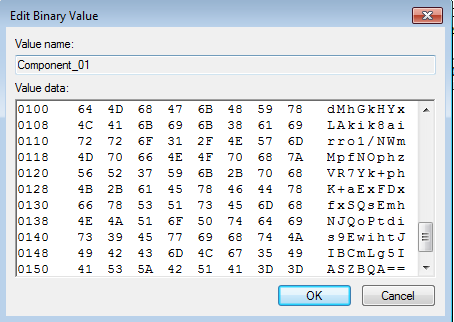
Registry keys for the persistance are added in various places, i.e:
HKEY_USERS -> [current user’s SID]:
- “Software\Microsoft\Windows\CurrentVersion\Run”
- “Software\Microsoft\Windows\CurrentVersion\RunOnce”
- “Software\Microsoft\Windows\CurrentVersion\Policies\Explorer” -> “Run”
- “Software\Microsoft\Command Processor” -> “AutoRun”
However, when the encryption finishes successfully, the dropped sample is deleted.
Encryption process
Cerber can encrypt files in offline mode – it means it doesn’t need to fetch the key from the CnC server. Files that have been encrypted are fully renamed and appended with the extension typical for this ransomware: .cerber. Pattern of the name: [0-9a-zA-Z_-]{10}.cerber

The encrypted content has a high level of entropy and no patterns are visible. Below: visualization of bytes of square.bmp : left – original, right encrypted with Cerber:

Content of the encrypted file is different on every encryption – probably keys are dynamically generated. After encryption size of the file content is increased about 384 bytes* – it may suggest, that the RSA encrypted AES key is appended to the file (*depending on the file this value may vary a bit, probably because of various padding).
After executing it displays a ransom note in two forms: HTML and TXT. The note is available only in English. Example below:
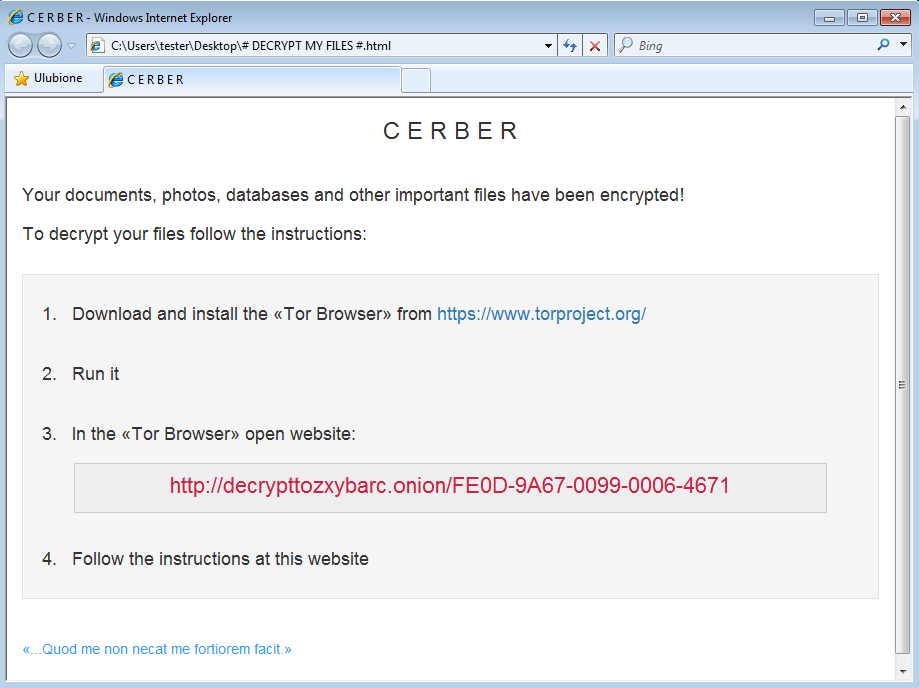
C E R B E RYour documents, photos, databases and other important files have been encrypted!
At the bottom of the ransom note attackers added a quote in Latin: «…Quod me non necat me fortiorem facit.» (“What doesn’t kill me, makes me stronger”). We can only speculate what they wanted to convey – to share their own motto, or to console the victim of the attack?
It comes also with a VB macro that is supposed to speak up the message with the help of a local text-to-speech emulator:
Set SAPI = CreateObject("SAPI.SpVoice") SAPI.Speak "Attention! Attention! Attention!" For i = 1 to 5 SAPI.Speak "Your documents, photos, databases and other important files have been encrypted!" Next Website for the victim
Each victim has a Web page that can be accessed via Tor. Although the ransom note is available only in English, the Tor website can be customized to several languages:

These pages contain further instructions to the victim and support for managing payments. The time to an increase in the ransom price is counted from the first access to this website.

To decrypt your files you need to buy the special software - <>.
Network communication
Cerber can manage well without CnC and accomplish its task offline. However, if given opportunity, it can communicate with CnC in order to send statistics from encryption process.
First, it fetches geolocation info (in JSON format) of the local computer by querying a genuine service: http:/ipinfo.io/json
Then, we can observe sending UDP requests to a predefined range of IP addresses:

Inside
Cerber samples come packed by some crypters/FUDs, so the code is not readable at first. Even when we unpack the core (i.e. 9a7f87c91bf7e602055a5503e80e2313), only a few strings are readable. It is caused by the fact that the authors decided to encrypt the strings and decrypt them just before the usage. Example:

The decrypting function takes the following parameters:
decrypt_string(char* input_buffer, DWORD input_lenght, DWORD key, BOOL is_unicode)
One of the few strings that hasn’t been encrypted was a check against anti-malware vendors (one of them is Malwarebytes). The list of vendors is in JSON – this format have been used extensively by Cerber.

Another interesting unencrypted string was a log, showing the statistics from encryption (the feature used if the malware is deployed in the debug mode):

Configuration file
Cerber comes with an encrypted resource, stored as RC Data. It is decrypted by a dedicated function:

After decryption, it turns out to be a configuration in JSON format (you can see it full here):
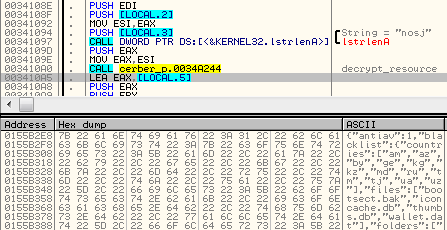
Configuration is rich in options. Contains i.e:
- a blacklist used to exclude some countries, languages, file names and directories from the attack
- a list of attacked extensions
- environment checks that are enabled
- whether or not to deploy the sample in a debug mode
- encryption settings and output extension
- public RSA key in base64 (decoded).
- files with ransom note to be dropped
- list of services used to obtain geolocation
- range of IPs where to send statistics (compare with IPs described in the section ‘Network communication’)
- format of statistics to be sent
Distributors can customize many things with the help of the config file. Changing the full look-and-feel of the malware – attacked extensions, ransom note and even extension of encrypted files – can make it appear like a new product. This flexibility made me wonder if the same package is not being distributed in a different campaign – not as a Cerber, but under some other name.
The distributor of the analyzed sample decided to exclude several countries form the attack (Armenia, Azerbaijan, Belarus, Georgia, Kyrgyzstan, Kazakhstan, Moldova, Russia, Turkmenistan, Tajikistan, Ukraine, Uzbekistan). It will also spare your default Windows directories, Tor browser and Bitcoin wallet.
Loading the key
The sample comes with a public RSA key shipped in the configuration file (described in the previous section).
Below – decrypting public key from Base64:

Key is imported using function CryptImportPublicKeyInfo.

Configuration mentioned: “rsa_key_size“: 576 – but it turns out to be a 2048 bit key (BLOB size – 276 bytes)
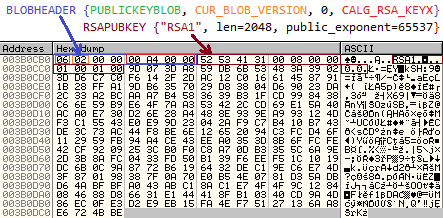
Installation
A file name of the dropped sample is created in a pretty interesting way. It is not fully random, but based on name of some file existing in the system, that is searched in the system using a random filter (format: “[random char]*[random char]. exe”, i.e “p*h.exe”):

The found file is compared with some built-in blacklist. When it pass the check, it is chosen as the new name of the dropped copy of the malware.
In order to prevent user from finding the malicious file by its creation timestamp it is changed to the timestamp of kernel32.dll existing on the local system.
After the successful installation, the initial malware sample terminates and deploys the dropped copy instead.

UAC Bypass
Cerber uses tricks to bypass Windows User Account Controll (UAC) and deploy itself with elevated privileges. It is achieved by the following steps:
- Search an executable in C:Windowssystem32, that can auto elevate it’s privileges.
- Search in it’s import table a DLL that can be hijacked
- Copy the DLL into %TEMP% folder and patch it – add a code in a new section and patch entry point in order to redirect execution there. It will be used in order to run the cerber sample with elevated privileges. It uses: WinExec(“[cerber_path] -eval 2524“, SW_SHOWNORMAL)
- Inject the code into explorer.exe – it is responsible for executing the UAC bypass. Creates a new folder in C:Windowssystem32 and copy there both files – an EXE and the patched DLL – under original names, then it deploys the EXE causing DLL to load and execute the malicious code.
- When the UAC bypass is executed successfully, it is signalized to the original cerber sample by setting a property cerber_uac_status – added to a Shell_TrayWnd. Then, the original sample deletes dropped files and exits. Otherwise, it tries the same trick with different pair of EXE + DLL.
See below how it looks in action:
First, it searches an application that can be used to elevate privileges. The check is based on the fields in application manifest:
true
Among it’s imported DLLs it searches a candidate suitable to be hijacked. This DLL is copied into %TEMP% folder

Then, it creates a suspended process of explorer.exe, allocates memory in it’s context and injects there own code. Details given below.
Injection into explorer is performed in several steps. First – malware is coping memory from the context of current process into the context of explorer.exe. Current image of Cerber sample is replicated into a memory allocated in explorer at 0x70000. Similarly, the page containing filled data is copied at offset 0x91000 in explorer.

In order to run the injected code when the explorer.exe is resumed, malware performs patching of the carrier’s Entry Point:

Now, Explorer’s execution starts from the call to injected code. It is a function of Cerber sample – at RVA 0x55E1, called with a parameter 0x91000 – pointer to the memory page containing various dynamically loaded data, like function’s handlers, paths of the files to be used, etc. From inside this code injected to explorer, the DLL patched for UAC bypass is copied under the original name – along with the appropriate EXE. The executable is deployed (using ShellExecuteExW) and along with it, the patched DLL also runs.

The d3d9.dll is used in order to run the Cerber sample with elevated privileges. Entry Point of the DLL is patched with a jump to the new section.

The new section contains the code that is supposed to execute the Cerber sample:
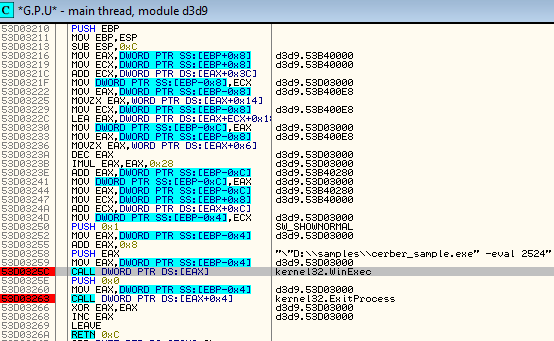
Successful UAC bypass is signalized by setting a property named “cerber_uac_status” in a found window of the class “Shell_TrayWnd“. The initial Cerber sample waits for this status to change. If the timeout passed and it didn’t changed it makes a new attempt of UAC bypass – using a different pair (EXE+DLL). Otherwise it cleans up the environment and terminates. Infection proceeds from inside of the elevated sample. 
In case if UAC level is set to default (or lower), Cerber can bypass it silently. However, in case if it is set to the highest, the following alert pops up:

It keeps reappearing till the user click “Yes”:
Conclusion
Cerber is a pretty powerful ransomware written with attention to details. This analysis highlighted only some of the elements. It has rich customization options and various tricks to make analysis harder. Although this product appeared recently, for sure its authors are not new in the field of malware development. We can expect it will be gaining popularity and may carry some new tricks in the future.











